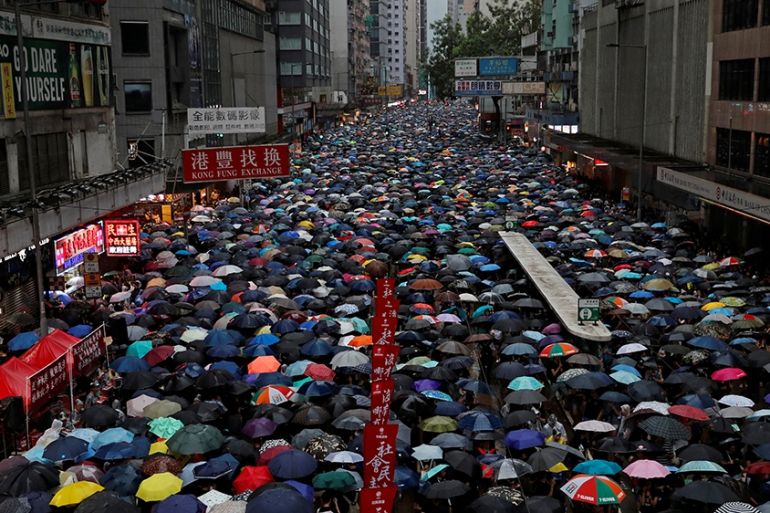Hundreds of thousands march in latest Hong Kong protest
The protesters’ demands include the complete retraction of a controversial extradition bill.

Hong Kong– In defiance of a police ban, tens of thousands of black-clad Hong Kong protesters packed into a park and have again flooded the streets of the Chinese territory for the eleventh straight week of anti-government demonstrations.
While only a rally at Victoria Park was permitted to proceed on Sunday, as police denied a permit for a 3.7-kilometre march to Hong Kong‘s central business district, the rally quickly became a massive march as crowds spilled out into neighbouring streets and moved west towards the original destination.
Keep reading
list of 4 itemsThe Take: Where are Hong Kong’s protesters now?
Hong Kong’s new security law comes into force amid human rights concerns
Hong Kong passes tough new national security law
Even as tropical rain began pouring down, the protesters remained undeterred and were covered with a sea of colourful umbrellas as they jammed major thoroughfares.
Organisers said an estimated 1.7 million people attended Sunday’s march, making it the second-largest demonstration since the protests began in early June.
To the beat of a stationary drummer, demonstrators inched through the crammed streets of a neighbourhood called Wan Chai, while a person holding a microphone led a chant demanding the resignation of Hong Kong’s embattled chief executive: “Carrie Lam, step down!”
Protests were originally sparked by the proposal of a now-shelved extradition bill, which would have allowed for the extradition of suspects to mainland China for trial, but have broadened into a wider movement against Chinese interference in the semi-autonomous region.
When Hong Kong returned to Chinese rule from its previous British colonial overseer in 1997, a “one country, two systems” framework was established to protect its unique civil liberties and freedoms, unseen on the mainland.
“We think this is an end game, the last time we fight,” said a 27-year-old lifeguard who asked to be identified as May, who wore a surgical mask to protect her identity. “We’re not stepping back this time.”

Protesters’ demands
Sunday’s march was organised by the Civil Human Rights Front (CHRF), the same group that drew millions of people to the streets in recent months.
“If [the Hong Kong Government and Beijing] think they can simply wait for our campaign to die down, they are dead wrong,” says Bonnie Leung, vice-convener of CHRF.
“They can’t scare us away from the campaign using violence and [threats]. Hongkongers will soldier on until [the government responds to our five demands].”
Those demands include the complete retraction of the proposed extradition bill, universal suffrage to choose Hong Kong’s leaders and amnesty for all those arrested in connection with the protests.
|
|
Leung also reiterated the peaceful nature of Sunday’s march, encouraging all of the “brave” protesters to participate.
Most of the demonstrations have begun peacefully but some have devolved into chaotic confrontations. Protesters have in recent weeks thrown bricks and projectiles at the police, who have used tear gas, rubber bullets, pepper spray and batons on protesters.
The peaceful marketing of Sunday’s protest – “Peaceful, Rational, Nonviolent” – is an effort to restore the image of the pro-democracy movement after a polarising airport protest this past week.
After a five-day airport occupation that forced the cancellation of hundreds of flights, a group of protesters on Tuesday night beat and tied up two mainland Chinese men.
The incident has tarnished the movement’s image and caused a public outcry.
The Chinese government has also ramped up its discourse, saying some protesters were exhibiting behaviour akin to “terrorism” and circulating footage of a military build-up in the bordering mainland city of Shenzhen.
Protesters on Sunday were unwavering in their fury over the police’s use of force in recent months. Police said they had fired at least 1,800 rounds of tear gas and 160 rubber bullets since the protests began in June.
“The police are extremely violent against citizens, that’s why I’m here,” said Liam, a 35-year-old protester.
However, Liam remains unfazed by the recent troop build-up in Shenzhen.
“I’m not worried. I believe this is a rumour to scare the Hong Kong citizens,” he said. Protesters will continue “until the government reacts to our demands,” he added.
The government initially expressed “regret” over the rally and said “it was most important to restore social order as soon as possible”. Later in the day, it described the protests as “generally peaceful”, but said “the participants occupied a number of thoroughfares on Hong Kong Island, seriously affecting traffic and causing much inconvenience to the community”.
It also pledged to “begin sincere dialogue with the public, mend social rifts and rebuild social harmony when everything has calmed down”.
Police said they had arrested more than 700 people since the mass demonstrations kicked off in early June.
Since the last escalation, the past week has been relatively quiet as both protesters and police seemed to take a few days to regroup. Several demonstrations were held on Saturday, including a teacher rally, a pro-government rally and an anti-government march.
